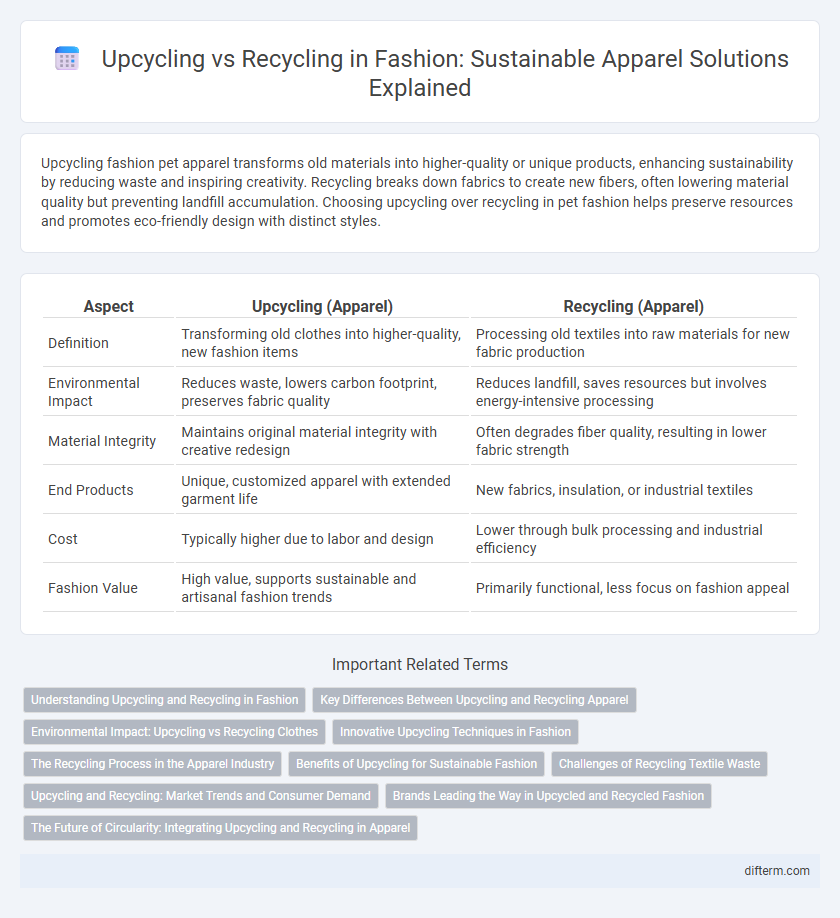Upcycling fashion pet apparel transforms old materials into higher-quality or unique products, enhancing sustainability by reducing waste and inspiring creativity. Recycling breaks down fabrics to create new fibers, often lowering material quality but preventing landfill accumulation. Choosing upcycling over recycling in pet fashion helps preserve resources and promotes eco-friendly design with distinct styles.
Table of Comparison
| Aspect | Upcycling (Apparel) | Recycling (Apparel) |
|---|---|---|
| Definition | Transforming old clothes into higher-quality, new fashion items | Processing old textiles into raw materials for new fabric production |
| Environmental Impact | Reduces waste, lowers carbon footprint, preserves fabric quality | Reduces landfill, saves resources but involves energy-intensive processing |
| Material Integrity | Maintains original material integrity with creative redesign | Often degrades fiber quality, resulting in lower fabric strength |
| End Products | Unique, customized apparel with extended garment life | New fabrics, insulation, or industrial textiles |
| Cost | Typically higher due to labor and design | Lower through bulk processing and industrial efficiency |
| Fashion Value | High value, supports sustainable and artisanal fashion trends | Primarily functional, less focus on fashion appeal |
Understanding Upcycling and Recycling in Fashion
Upcycling in fashion transforms old or discarded garments into higher-quality or unique pieces, preserving material integrity and reducing waste by extending product life cycles. Recycling apparel involves breaking down textiles to create raw materials for new fabric production, often requiring significant energy and resulting in lower fabric quality. Both methods aim to minimize environmental impact, but upcycling emphasizes creativity and value enhancement, while recycling focuses on material recovery and resource efficiency.
Key Differences Between Upcycling and Recycling Apparel
Upcycling apparel involves creatively transforming old garments into higher-value fashion pieces, preserving fabric quality and design elements, while recycling breaks down textiles to create raw materials for new fabrics, often resulting in material degradation. Upcycling emphasizes originality and uniqueness, making each item one-of-a-kind, whereas recycling prioritizes sustainability through resource recovery and mass production of new fibers. Brands leveraging upcycling typically highlight craftsmanship and exclusivity, whereas recycling suits large-scale circular fashion initiatives aiming to reduce textile waste footprint.
Environmental Impact: Upcycling vs Recycling Clothes
Upcycling apparel reduces textile waste by transforming old garments into new, higher-value products, significantly lowering the carbon footprint compared to traditional recycling processes. Recycling clothes often involves mechanical or chemical treatments that can degrade fabric quality and consume substantial energy and water resources. Emphasizing upcycling in the fashion industry supports circularity and conserves natural resources, making it a more sustainable choice for reducing environmental impact.
Innovative Upcycling Techniques in Fashion
Innovative upcycling techniques in fashion transform discarded apparel into high-value, trend-forward pieces by incorporating advanced fabric manipulation and digital customization. Techniques such as 3D fabric printing, laser cutting, and hand embroidery enhance durability and aesthetic appeal while reducing environmental impact. These methods not only extend garment life cycles but also drive sustainable consumption in the fashion industry.
The Recycling Process in the Apparel Industry
The recycling process in the apparel industry involves collecting used textiles, sorting them by fiber type, and mechanically or chemically breaking them down into raw materials for new fabric production. Mechanical recycling typically shreds garments into fibers, which are then spun into yarn, while chemical recycling dissolves fibers to regenerate high-quality materials. This process reduces textile waste and conserves resources by extending the lifecycle of fabrics such as cotton, polyester, and blends within sustainable fashion systems.
Benefits of Upcycling for Sustainable Fashion
Upcycling in sustainable fashion preserves the original value of apparel by transforming old garments into higher-quality, unique pieces, reducing the demand for new textile production and minimizing waste in landfills. This process lowers carbon emissions significantly compared to recycling, as it requires less energy and fewer resources, supporting eco-friendly practices in the fashion industry. Upcycled fashion promotes creativity and consumer engagement, driving a circular economy that champions environmental responsibility and reduces the fast fashion footprint.
Challenges of Recycling Textile Waste
Recycling textile waste faces significant challenges due to mixed fabrics, contamination with dyes, and the degradation of fiber quality during mechanical processing. Advanced sorting technologies and chemical recycling methods are often required but remain costly and energy-intensive. These obstacles limit the scalability and economic viability of textile recycling compared to more sustainable upcycling practices in fashion.
Upcycling and Recycling: Market Trends and Consumer Demand
Upcycling in the fashion industry is gaining momentum as consumers increasingly seek unique, sustainable apparel that reduces waste by transforming old garments into higher-value products. Recycling also plays a crucial role by breaking down textile fibers to produce new fabrics, although it often faces challenges related to fiber quality and color contamination. Market trends indicate a growing preference for upcycled fashion due to its environmental benefits and creative appeal, driving brands to integrate both practices to meet rising consumer demand for eco-conscious clothing options.
Brands Leading the Way in Upcycled and Recycled Fashion
Brands leading the way in upcycled and recycled fashion, such as Patagonia, Eileen Fisher, and Stella McCartney, prioritize sustainability by transforming waste materials into high-quality garments. These innovators implement circular fashion models that reduce textile waste and carbon footprints through creative reuse and advanced recycling technologies. Their commitment to eco-conscious production sets industry standards, inspiring widespread adoption of sustainable apparel practices.
The Future of Circularity: Integrating Upcycling and Recycling in Apparel
Upcycling enhances apparel sustainability by transforming waste materials into higher-value products, reducing the need for virgin resources and minimizing environmental impact. Recycling processes break down old textiles into fibers, supporting the creation of new fabrics and decreasing landfill contributions. Combining upcycling and recycling in a circular fashion model accelerates resource efficiency and promotes innovative design, driving the future of sustainable apparel.
upcycling vs recycling (apparel) Infographic

 difterm.com
difterm.com